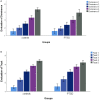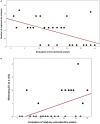Violence Exposure Is Associated With Atypical Appraisal of Threat Among Women: An EEG Study
- PMID: 33510667
- PMCID: PMC7835125
- DOI: 10.3389/fpsyg.2020.576852
Violence Exposure Is Associated With Atypical Appraisal of Threat Among Women: An EEG Study
Abstract
Introduction: The present study investigates the association of lifetime interpersonal violence (IPV) exposure, related posttraumatic stress disorder (IPV-PTSD), and appraisal of the degree of threat posed by facial avatars.
Methods: We recorded self-rated responses and high-density electroencephalography (HD-EEG) among women, 16 of whom with lifetime IPV-PTSD and 14 with no PTSD, during a face-evaluation task that displayed male face avatars varying in their degree of threat as rated along dimensions of dominance and trustworthiness.
Results: The study found a significant association between lifetime IPV exposure, under-estimation of dominance, and over-estimation of trustworthiness. Characterization of EEG microstates supported that lifetime IPV-PTSD modulates emotional appraisal, specifically in encoding and decoding processing associated with N170 and LPP evoked potentials. EEG source localization demonstrated an overactivation of the limbic system, in particular the parahippocampal gyrus, in response to non-threatening avatars. Additionally, dysfunctional involvement of attention-related processing anterior prefrontal cortex (aPFC) was found in response to relatively trustworthy avatars in IPV-PTSD individuals compared with non-PTSD controls.
Discussion: This study showed that IPV exposure and related PTSD modulate individuals' evaluation of facial characteristics suggesting threat. Atypical processing of these avatar characteristics was marked by group differences in brain regions linked to facial processing, emotion regulation, and memory.
Keywords: EEG neuroimaging; IPV-PTSD; face evaluation; microstates; source localization.
Copyright © 2021 Perizzolo Pointet, Moser, Vital, Rusconi Serpa, Todorov and Schechter.
Conflict of interest statement
The authors declare that the research was conducted in the absence of any commercial or financial relationships that could be construed as a potential conflict of interest.
Figures






References
-
- American Psychiatric Association (2000). Diagnostic Criteria from DSM-IV-TR: American Psychiatric Pub. Philadelphia, PA: American Psychiatric Association.
-
- Arnold M. B., Gasson J. A. (1954). The Human Person; an Approach to an Integral Theory of Personality. New York, NY: Ronald Press Company.
-
- Beck A., Steer R. (1987). The Revised Beck Depression Inventory. San Antonio, TX: Psychological Corporation.
LinkOut - more resources
Full Text Sources
Other Literature Sources

